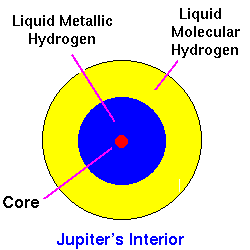The Interior of
Jupiter
 Most of the interior of Jupiter is liquid (primarily hydrogen and about 10%
helium). The central temperatures are thought to lie in the 13,000-35,000
degree Celsius range, and the central pressure is about 100 million Earth
atmospheres. We infer indirectly that the small core (perhaps a few tens of
Earth masses) is rocky.
Most of the interior of Jupiter is liquid (primarily hydrogen and about 10%
helium). The central temperatures are thought to lie in the 13,000-35,000
degree Celsius range, and the central pressure is about 100 million Earth
atmospheres. We infer indirectly that the small core (perhaps a few tens of
Earth masses) is rocky.
Liquid Metallic Hydrogen
The inner layers of highly compressed hydrogen on Jupiter
are in a state that can
only be produced on the Earth in the most extreme laboratory
conditions--in fact under the extreme conditions of powerful laser
laboratories, of which the most powerful in the world
is currently here at the UR (the Laboratory for Laser Energetics).
(These lasers converge on a target producing
an extremely large pressure.)
Normally, hydrogen does not conduct heat or
electricity very well, which are defining characteristics for a metal. Thus,
under normal conditions hydrogen is not a metal. Under the extreme pressure
found deep inside Jupiter, theory suggests that the electrons are released from
the hydrogen molecules and are free to move about the interior. This causes
hydrogen to
behave as a metal: it becomes conducting for both heat and electricity.
The intense magnetic field of
Jupiter is thought to result from electrical currents in this region of
metallic hydrogen that is spinning rapidly and thought to
compose 75% of the planet's mass. We are limited in our understanding of
Jupiter's interior by the fact that we have little
laboratory knowledge of the
behavior of hydrogen under such conditions and are forced to rely on theory,
but this will change as the field of laser laboratory astrophysics emerges.
Conversely, the properties of Jupiter provide a stringent test of our
understanding of matter under such extreme conditions.
Internal Source of Energy
Jupiter radiates 1.6 times a much energy as falls on it from the
Sun. Thus, Jupiter
has an internal heat source. It is thought that much of this
heat is residual heat left over from the original collapse of the primordial
nebula to form the Solar System, but some may come from slow contraction
(liquids are highly incompressible, so Jupiter cannot be contracting very
much.) This internal heat source is presumably responsible for driving the
complex weather pattern in its atmosphere, unlike the Earth where the primary
heat source driving the weather is the Sun.
A Large Planet or a Failed Star?
Calculations suggest that Jupiter
lacks the mass to initiate hydrogen fusion reactions in its core and become a
star by about a factor of 100. Since factors of 100 are not so large on
astrophysical mass scales, it is legitimate at some level to
view Jupiter as either a very large planet,
or a failed star.
 Most of the interior of Jupiter is liquid (primarily hydrogen and about 10%
helium). The central temperatures are thought to lie in the 13,000-35,000
degree Celsius range, and the central pressure is about 100 million Earth
atmospheres. We infer indirectly that the small core (perhaps a few tens of
Earth masses) is rocky.
Most of the interior of Jupiter is liquid (primarily hydrogen and about 10%
helium). The central temperatures are thought to lie in the 13,000-35,000
degree Celsius range, and the central pressure is about 100 million Earth
atmospheres. We infer indirectly that the small core (perhaps a few tens of
Earth masses) is rocky.